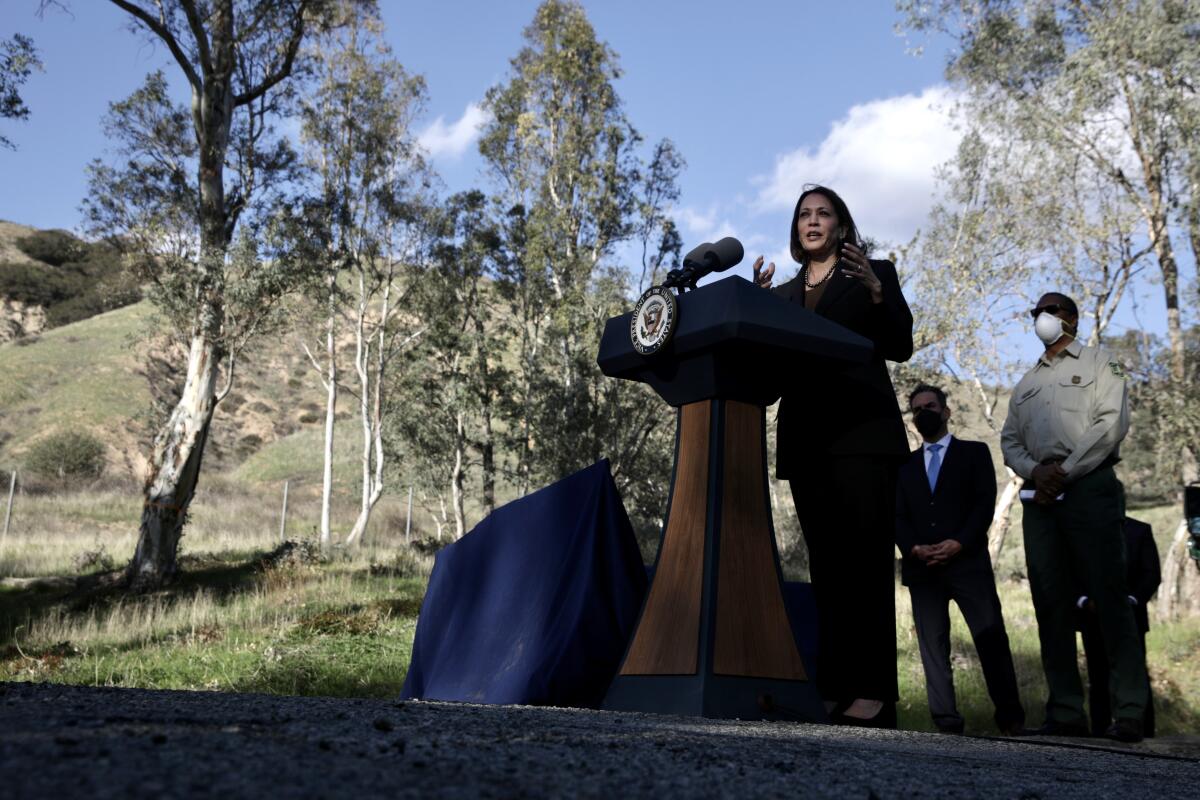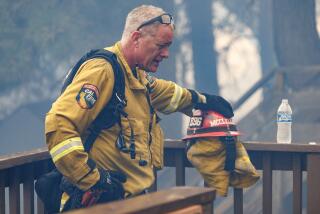Kamala Harris announces wildfire money in California visit

With large, damaging wildfires becoming more common due to the effects of climate change, the federal government is redoubling its efforts to mitigate them.
That’s the message Vice President Kamala Harris delivered Friday during a visit to San Bernardino in which she highlighted billions of dollars in federal funding to reduce the risk of wildfires and help communities recover from them.
“It is about recognizing that we cannot, as a government or as a society or people who care, only respond in reaction to a moment of harm or danger,” said Harris, who appeared alongside a host of officials including Agriculture Secretary Tom Vilsack and California Gov. Gavin Newsom. “We must also be able to use technology and common sense and the expertise of those on the ground to understand we have the tools to predict these wildfires ahead of time.”
The federal government will provide $600 million in disaster money to help California recover from a historically severe wildfire season that saw fires scorch nearly 2.6 million acres and burn from one side of the Sierra Nevada to the other for the first time — and then the second time. That money is part of a $1.3-billion commitment to local communities across the country to help clean up hazardous materials, restore forests and repair infrastructure damaged by wildfires, Harris said.
Harris also announced $48 million in new funding for the Joint Chiefs’ Landscape Restoration Partnership — a joint effort between the National Resources Conservation Service and the U.S. Forest Service to conduct forest management projects, such as the thinning of vegetation and the creation of firebreaks. The funding will support 17 new projects in the West, including two in California — one on the Six Rivers National Forest and one on the Klamath National Forest, Vilsack said.
The funding supplements $5 billion worth of wildfire preparedness and resilience money that was set aside by the bipartisan infrastructure bill President Biden signed into law in November. That money will help support federal firefighter salaries, fund grants to create defensible space around communities, pay for burned area rehabilitation efforts and reduce hazardous fuels.
Speaking on a bright and blustery afternoon, Harris made her announcement at the Forest Service’s Del Rosa station, located just at the edge of the San Bernardino Forest. The station abuts a hilly residential neighborhood in northeast San Bernardino and is home to the Del Rosa Hotshots, a crew that works on all phases of wildland fire suppression.
At various points during the outdoor news conference, protesters could be heard chanting anti-Biden slogans through a bullhorn.
Before her appearance, Harris took an aerial tour of the San Bernardino National Forest to view the scars of the El Dorado fire, sparked by a pyrotechnic device at a gender reveal party in the fall of 2020, which burned nearly 23,000 acres and resulted in the death of a firefighter.
That fire season was the worst in California history in terms of acres burned, but such severe years have become more common over time, said Tony Scardina, deputy regional forester for the Forest Service’s Pacific Southwest Region.
In the 20 years ending in 2019, wildfires burned 12 million acres in California; over just the past two years, 7 million acres in the state burned, he said.
“So we talk about the acceleration of fire behavior related to drought, related to climate change and then dealing with how do we help communities in that wildland urban interface,” he said.
The vice president’s announcement came days after the Forest Service unveiled a 10-year plan to quadruple fuels reduction treatments in the western U.S. in a bid to cut down on vegetation that could stoke a fast-moving wildfire and make landscapes more resilient to fires’ effects. The goal is to treat up to 20 million more acres on national forest and grass lands and up to 30 million more acres on other federal, state, tribal and private lands.
The infrastructure bill will provide $655 million per year for five years for this work, on top of annual Forest Service allocations for fuels reduction and restoration activities that totaled $262 million in fiscal year 2021. Assuming this baseline continues, the funds represent a 350% increase over past yearly investments, the Forest Service said.
Still, the total cost of the 10-year plan is estimated to be roughly $50 billion — $20 billion for treatments on national forest lands and $30 billion on non-national forest lands — leaving some of it yet to be funded.
Experts say the shift toward mitigation is sorely needed as costs to douse wildfires have ballooned. The U.S. Forest Service averaged nearly $2.2 billion on annual fire suppression costs from 2016 to 2020, including more than $4 billion last year. In California, the Forest Service spent $999 million during fiscal year 2021, which includes costs stemming from the 1-million-acre August Complex fire, the largest in state history.
“What we’re realizing is that the wildfire season continues to grow longer and longer every year — we query whether it can even be called a season anymore,” said Julia Stein, project director for the Emmett Institute on Climate Change and the Environment at UCLA School of Law. “So while the need for suppression funding is still great, it’s important for us to be thinking ahead and taking measures to prevent fires before they start.”
Meanwhile, the state’s long and ongoing housing crisis has led more people to move into communities that abut wilderness areas, putting them directly in the line of fire — literally — and making interventions aimed at protecting neighborhoods even more necessary, she said.
“Since we know that climate change is going to increase the likelihood of these mega wildfires here in California and across the western United States, it’s important to start thinking ahead and getting out in front of these crises rather than just being in a reactive pose,” she said.
Times staff writer Noah Bierman contributed to this report.
More to Read
Sign up for Essential California
The most important California stories and recommendations in your inbox every morning.
You may occasionally receive promotional content from the Los Angeles Times.












